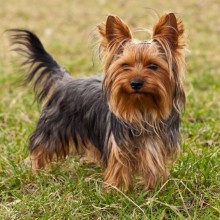Yorkshire Terrier
Lifestyle Needs

The Yorkshire Terrier or ‘Yorkie’ is a favourite with people who prefer a very small dog. In spite of his size he is often described as feisty. In the past terriers were bred for hunting and many have retained this trait. Due to his size and popularity the Yorkie is often pampered unnecessarily, but he is better behaved and happier if treated simply as a dog. The Yorkie’s long, silky coat needs careful, regular grooming, so if this is something you are not happy to do, the Yorkie is not for you.
Genetic Diversity
(Known as Coefficient of Inbreeding: 'COI'. It should be as low as possible.)
The UK Kennel Club breed average COI is 9.6% - See 'A Beginners Guide to COI'
Gene Pool Size
(Known as Effective Population Size: 'EPS')
40.24
EPS is a measure of how many individuals are contributing genetically to a breed population. It is a measure of the size of the gene pool in a breed. Lower than 100 is considered critical by conservationists and below 50 brings a breed close to extinction. For more information see the Kennel Club article.
Health and Welfare Problems due to Conformation
(Body shape and physical characteristics)
- The Yorkie’s long, silky coat can get in the way of him fully enjoying life if it is not cut or clipped. It will harbour dirt and dust, become easily tangled and matted and prevent him seeing perfectly.
- The extremely small versions of the breed tend to be more fragile, so a larger type may make a better family or companion pet. There is a risk of leg fractures occurring due to the Yorkie’s small, delicate bones.
- The extreme small size of his mouth can cause poor dentition and the retention of baby teeth.
- There is a risk of leg fractures occurring due to the Yorkie’s small delicate bones.
BVA/KC Health Schemes: www.bva.co.uk/chs
- Chiari malformation Syringomyelia (CMSM)
- Eye Disease
Estimated Breeding Values (EBVs) : No EBVs are currently available for this breed
www.thekennelclub.org.uk/about-ebvs
DNA Tests Available
DogWellNet and IPFD Harmonisation of Genetic Testing for Dogs (HGTD)
www.dogwellnet.com/breeds
- Progressive Retinal Atrophy (PRA prcd)
- Primary Lens Luxation (PLL)
- Hyperuricosuria (HUU)
Availability of a DNA test does not mean that it is always necessary or even desirable for breeders to use this test.
Other Breed-Specific Health Screening Schemes
- Patellar luxation test
Ask the breeder to show you the certificates for the above tests/screening for both parents. If any of the above tests have not been considered necessary by the breeder (and there may be good reasons), ask her to explain why.
Other Diseases Reported
(For which there are currently no genetic or screening tests for sire or dam)
- Atopy
- Mitral Valve disease (MVD)
- Hip joint abnormality
- Fragile bones
- Bladder stones
- Eye disease (cataracts, ulcers, ‘dry eye’)
- Heart disease (mitral valve disease)
- Periodontal disease
- Patella luxation
- Atlantoaxial subluxation
Ask the breeder about the medical history of the parents, grandparents and great grandparents. Consider carefully whether to purchase a puppy if some of these or other diseases are in the family line.
Ask about the breeder’s policy in cases of serious genetic diseases occurring to your puppy in later life. Good breeders will request to be informed of such events in order to improve future breeding decisions.
You are strongly advised to buy from a breeder who uses (or is prepared to use) the AWF Puppy Contract and Puppy Information Pack (PIP): www.puppycontract.org.uk
The breeder should also be familiar with the CFSG/DBRG Code of Practice for Dog Breeding